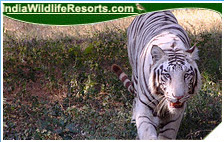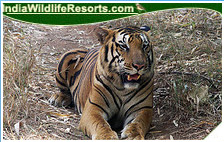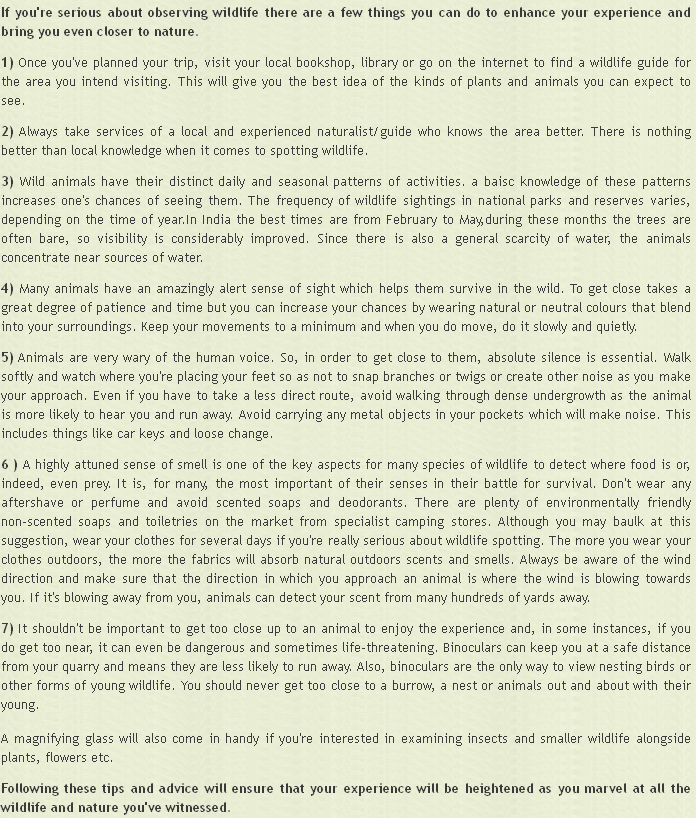Royal Bengal Tiger Tour
Kolkatta > Sunderbans > Kolkatta > Nagpur > Kanha National Park > Bandhavgarh National Park > Jabalpur > Agra > Delhi
Day 01: Arrive Kolkatta :
On arrival at the airport meet with our representative and transfer to the hotel. Overnight stay at hotel.
Day 02: Kolkata - Basanti (100 km) - Sunderbans (30 km)
 Morning after breakfast drive to Basanti. From Basanti you will be transferred by motor fitted country boat to the tourist lodge located in the Sunderbans. Sundarbans is home to Royal Bengal tigers, Ridley Sea Turtles and many other wildlife species. In afternoon you will set out to explore the wildlife from the watchtower near the lodge. Overnight stay will be at the tourist lodge.
Morning after breakfast drive to Basanti. From Basanti you will be transferred by motor fitted country boat to the tourist lodge located in the Sunderbans. Sundarbans is home to Royal Bengal tigers, Ridley Sea Turtles and many other wildlife species. In afternoon you will set out to explore the wildlife from the watchtower near the lodge. Overnight stay will be at the tourist lodge.
Day 03: Sunderbans
Morning after breakfast full day river cruise with packed lunch. Later you will have a halt at Sudhanyakhali watchtower (where you may spot the Royal Bengal Tiger) and you will also get to view the Mangrove forests from the creeks. Overnight stay at the lodge.. Watch Mangrove forest from the creeks. Return to Lodge for overnight stay.
Day 04: Sunderbans / Kolkatta (130 km) / Nagpur
Early morning drive to Howrah Railways station to board the train for Nagpur. Geetanjali exp- Lv. 1255 hrs. Arrv. 0735 hrs. next morning. Overnight on board.
Day 05: Arrive Nagpur / Kanha National Park (270 km)
On arrival transfer to Kanha national park. On arrival check in Jungle resort. In the afternoon safari to the national park. Overnight stay at resort.
Kanha National Park : Kanha's sal and bamboo forests, rolling grasslands and meandering streams stretch over 940 sq km in dramatic natural splendor. This is original Kipling country, of which he wrote so vividly in his Jungle Book. The same abundance of wildlife species exists today in Kanha National Park, which forms the core of the Kanha Tiger Reserve created in 1974 under Project Tiger. The park is the only habitat of the rare hardground barasingha (Cervus Duvaceli Branderi). In the 1930s, the Kanha area was divided into two sanctuaries: Hallon and Banjar, of 250 sq km and 300 sq km each. Though one of these was subsequently disbanded, the area remained a protected one until 1947. Depletion of the tiger population in the years that followed led to the area being made an absolute sanctuary in 1952. By a special statute in 1955, Kanha National Park came into being. Since then, a series of stringent conservation programmes for the protection of the park's flora and fauna has given Kanha its deserved reputation for being one of the finest and best administered National Parks in Asia, an irresistible attraction for all wildlife lovers and a true haven for its animal and avian population
Day 06: Kanha National Park
Morning & after noon Jeep/elephant Safari to the jungle following different trails inside park. Overnight stay at resort.
Day 07:Kanha National park / Bandhavgarh National Park (250 km)Tiger Tours
 Morning after breakfast at the resort drive to the Bandhavgarh national park. On arrival check in at the resort. In the afternoon game drive to the national park. Overnight stay at resort.
Morning after breakfast at the resort drive to the Bandhavgarh national park. On arrival check in at the resort. In the afternoon game drive to the national park. Overnight stay at resort.
Bandhavgarh National Park: Bandhavgarh National Park is spread at vindhya hills in Madhya Pradesh. Bandhavgarh National Park consists of a core area of 105 sq km and a buffer area of approximately 400 sq km of topography varies between steep ridges, undulating, forest and open meadows. Bandhavgarh National Park is known for the Royal Bengal Tigers. The density of the Tiger population at Bandhavgarh is the highest known in India.
Bandhavgarh National Park was the former hunting preserve of the Maharaja of Rewa and at present is a famous natural hub for White Tigers. White Tigers, now a major attraction around the world's zoos, were first discovered in Rewa, not far from here. The terrain is broken, with rocky hill ranges, running roughly east west, interspersed with grassy swamps and forested valleys. Bandhavgarh National Park is one of the finest national park in the India and has the distinction of harboring the highest concentration of tigers per unit area of forest. The Bandhavgarh National Park is spread over on area of 448 sq km with a cross area of 105 sq km. At the center of the park is the bandhavgarh hill, rising 811 meters above sea level and surrounding it are a sloping valleys, These valleys end in small, swampy meadows locally known as "bohera".
Bandhavgarh was declared a national park in 1968. Since then many steps have been taken to retain Bandhavgarh National Park as an unspoilt national habitat for a variety of wildlife peculiar to the area. These includes gaur (Indian bison), sloth bear, leopard, porcupine, wild boar, sambhar and spotted deer, among others and of course, the tiger.
Day 08: Bandhavgarh National Park
Morning jeep/Elephant safari to the national park for Tiger tracking. In the afternoon Jeep safari inside park. Overnight stay at jungle lodge.
Day 09: Bandhavgarh National Park / Umaria / Agra
Morning safari to the national park. In the evening transfer to the Umaria railway station to board train for Agra. Overnight on board.
Day 10: Arrive Agra
On arrival at the railway station meet with our representative and transfer to the hotel.
Today we visit Taj Mahal, symbol of eternal love, which stands on the banks of River Yamuna. It was built by the 5th Mughal emperor, Shah Jehan in the year 1631 in memory of his wife, Mumtaz Mahal. It was completed in 22 years. Further we visit Agra Fort, taken over from the Lodhis by the Mughal Emperor Akbar in the late 16th century. The Fort can be more accurately described as a walled palatial city. It was built from red sandstone, often inlaid with white marble & intricate decorations.
We will also visit Sikandara, Akbar's tomb. His son Jahangir completed the construction of the tomb in the year 1613. Itmad-Ud-Daulah's Tomb, built by Nur Jahan between 1622 and 1628. It belongs to the father of Nur Jahan, Ghiyas-ud-Din Beg. He was the Wajir (Chief Minister of Emperor Jehangir). This white marble tomb was. This tomb was the first complete marble Mughal structure.) Later transfer to the hotel for overnight at hotel.
Day 11: Agra / Delhi
Morning after breakfast drive to Delhi. On arrival check in at the hotel. Rest of the day free at leisure. Overnight at hotel.
Day 11: Departure
Morning after breakfast full day city sightseeing tour Old Delhi & New Delhi.
Old Delhi - the 350-year-old walled city was built by Emperor Shah Jehan in 1648 as his capital. Opposite the fort are the black and white onion dome and minarets of the Jama Masjid, the most elegant mosque in India. Raj Ghat is worth a visit where Mahatma Gandhi was cremated in 1948.
New Delhi - the new capital designed by Sir Edward Lutyens. An interesting drive in the one passing through the impressive Rajpath from the World War I memorial arch, the India Gate towards the Presidential Palace. Visit Humayun's Tomb built in 1565 AD, Safdarjung's Tomb, the Qutub Minar, 72 meters high and the most curious antique, the uncorroded Iron Pillar, which dates back to the 4th century AD.
Late in the evening transfer to the international airport to board the flight for onward destination.
Tour and Services Ends.
Royal Bengal Tiger Tour (Tour Highlight )
| Sundarbans | River Cruise, Mangrove Forests, Royal Bengal Tigers. |
| Kanha National Park | Jeep / Elephant Safari in the National Park, Hallon and Banjer Sanctuaries. See Tigers, Barasinga. |
| Bandhavgarh National Park | Jeep / Elephant Safari in the National Park. |
| Agra | Taj Mahal, Sikandra. |
| Delhi | Birla Temple, Humayun’s Tomb, Jama Masjid, Red Fort, India Gate, Parliament House, President House, Qutub Minar. |
Tiger Spotting Tips

Get a Call Back from us
Please provide us your contact number and convenient time, our expert will call back to you.








